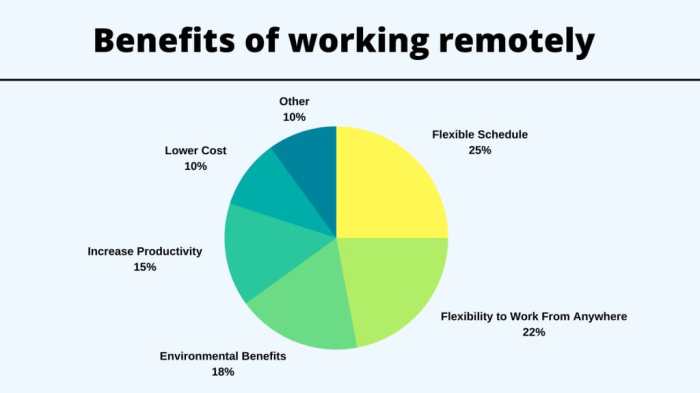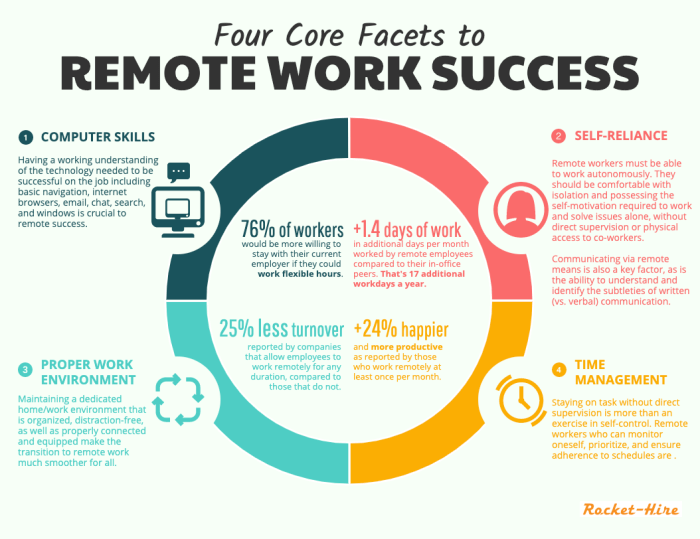Kicking off with Remote Work Productivity, this topic delves into the factors, strategies, tools, and mental health aspects that shape productivity in remote work settings. Get ready to boost your efficiency and well-being while working remotely!
Factors affecting remote work productivity

In the age of remote work, there are several key factors that can significantly impact productivity. Factors such as the physical workspace, technology, and work-life balance play a crucial role in determining how efficient and effective remote workers can be. Let’s dive into the details of these factors and how they compare to in-office productivity.
Physical Workspace
The physical workspace is essential for remote work productivity. A comfortable and organized work environment can help minimize distractions and promote focus. Factors such as proper lighting, ergonomic furniture, and a quiet space can contribute to increased productivity. On the other hand, working in a cluttered or uncomfortable space can hinder concentration and efficiency.
Technology
The technology available to remote workers also plays a significant role in their productivity. Reliable internet connection, up-to-date software, and efficient communication tools are essential for seamless remote work operations. Issues such as slow internet speed, outdated equipment, or inadequate software can lead to delays and decrease productivity levels.
Work-Life Balance
Maintaining a healthy work-life balance is crucial for remote work productivity. Without clear boundaries between work and personal life, remote workers may struggle to disconnect and recharge. Setting specific work hours, taking breaks, and engaging in activities outside of work are important for overall well-being and productivity. In-office workers may have an easier time separating work from personal life due to physical distance from their workspace.
Challenges in Remote Work Productivity vs. In-Office Productivity
Remote work productivity faces unique challenges compared to in-office productivity. Issues such as feelings of isolation, lack of supervision, and difficulty in collaboration can impact remote workers differently than those in a traditional office setting. On the other hand, in-office workers may face distractions from colleagues, frequent meetings, and a less flexible work schedule.
Strategies to enhance remote work productivity

Working remotely comes with its own set of challenges, but with the right strategies in place, you can boost your productivity and efficiency while working from home.
Establishing a Routine
One of the key strategies to enhance remote work productivity is establishing a daily routine. Set specific work hours and stick to them to create a sense of structure and discipline. Start your day at the same time each morning, take regular breaks, and have a designated workspace to signal to your brain that it’s time to focus.
Setting Boundaries
It’s essential to set boundaries between work and personal life when working remotely. Communicate your work hours to family members or housemates, and avoid working from the couch or bed to maintain a separation between work and relaxation. Setting boundaries helps prevent burnout and ensures you have time for self-care.
Managing Distractions
Distractions are common when working from home, but there are strategies you can use to stay focused. Create a to-do list at the beginning of each day to prioritize tasks, use tools like noise-canceling headphones to block out background noise, and turn off notifications on your phone or computer during focused work periods. Find a productivity technique that works for you, whether it’s the Pomodoro method or time-blocking, to maximize your efficiency.
Tools and technologies for remote work productivity
In today’s remote work landscape, having the right tools and technologies is crucial to ensure productivity and efficiency. These tools streamline communication, project management, and collaboration, ultimately leading to better outcomes for remote teams.
Essential tools for remote work productivity
- Video conferencing platforms like Zoom or Microsoft Teams enable face-to-face communication, fostering a sense of connection among team members.
- Project management tools such as Trello, Asana, or Jira help teams organize tasks, set deadlines, and track progress in a structured manner.
- Collaboration tools like Google Workspace or Microsoft Office 365 allow real-time editing of documents, spreadsheets, and presentations, enhancing teamwork and efficiency.
- Time tracking software such as Toggl or Harvest helps employees monitor their time spent on tasks, identify time-wasting activities, and improve time management skills.
Comparison of project management tools and communication platforms
- Project management tools like Trello are known for their user-friendly interface and visual approach to task management, while Jira offers more advanced features suitable for complex projects.
- Communication platforms such as Slack prioritize real-time messaging and collaboration, whereas Microsoft Teams integrates seamlessly with other Microsoft tools for a more comprehensive workspace.
Optimizing remote work productivity with time tracking software and collaboration tools
- Time tracking software helps employees stay accountable for their time, leading to increased productivity and better time management skills.
- Collaboration tools facilitate seamless teamwork by allowing team members to work on the same documents simultaneously, provide feedback in real-time, and stay updated on project progress.
Mental health and well-being in remote work
Maintaining mental health and well-being is crucial for remote workers to stay productive and motivated. The impact of mental health support on productivity cannot be understated, as it directly affects an individual’s ability to focus, stay motivated, and manage stress effectively.
Tips for maintaining work-life balance and preventing burnout
- Set boundaries between work and personal life by establishing a designated workspace and sticking to a schedule.
- Take regular breaks throughout the day to recharge and avoid burnout.
- Engage in physical activities or hobbies outside of work to reduce stress and improve overall well-being.
- Practice mindfulness techniques such as meditation or deep breathing exercises to stay centered and focused.
Ways to promote social connections and combat feelings of isolation, Remote Work Productivity
- Schedule virtual coffee breaks or team bonding activities to maintain social connections with colleagues.
- Join online communities or forums related to your industry to network and engage with like-minded professionals.
- Participate in virtual team meetings or brainstorming sessions to foster collaboration and communication.
- Reach out to friends and family members regularly to maintain a sense of social support and belonging.
